To the Moon and beyond
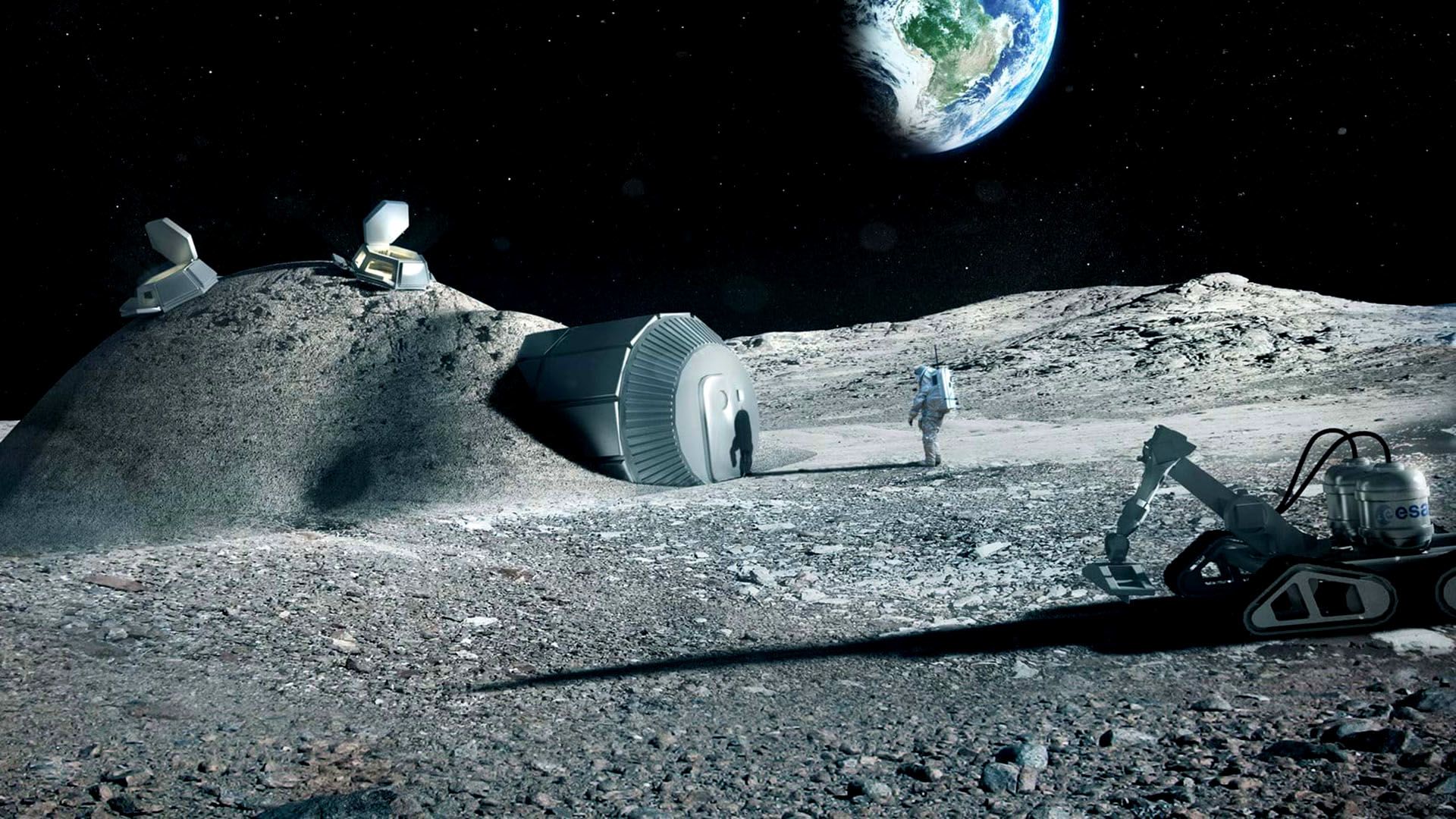
Donald Trump wants humans back on the Moon by 2024, as part of a new spacefaring age.
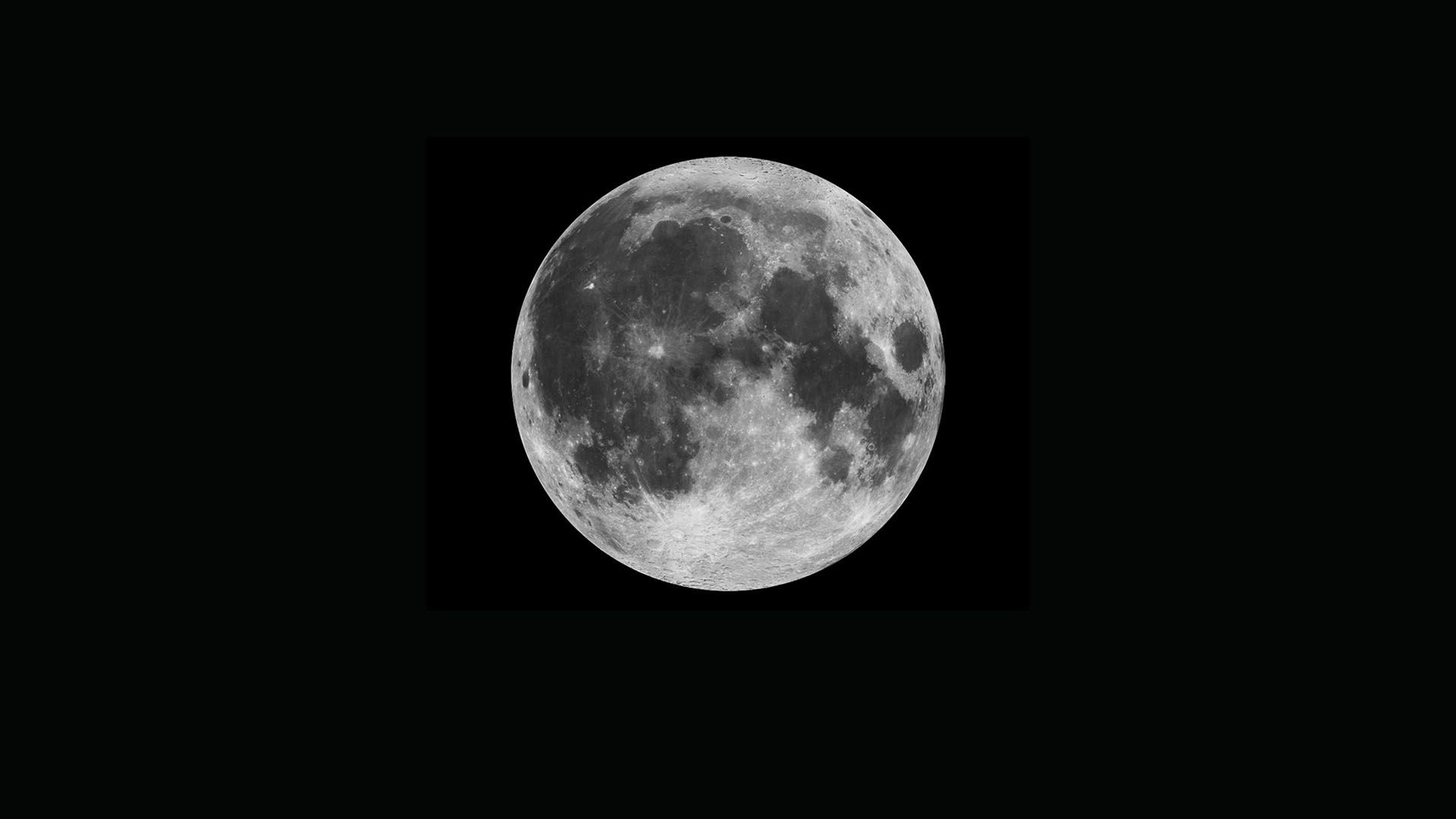
But what will it take to get there?

A 12-wheeled vehicle kicks up a haze of gunpowder-grey dust as it makes tracks across undulating terrain. The “space truck” has a pressurised cabin, allowing the two astronauts inside to breathe without their spacesuits.
They’re tired after a day spent investigating water-ice deposits a few kilometres from their base.
This is the Moon in 2050.
As the rover rounds the imposing sides of a large crater, the astronauts catch the glint of mirrors mounted on its rim. The mirrors beam sunlight into the crater, powering a mining operation to extract water-ice within. On the left, the truck passes a landing pad - flattened out by microwaving the lunar soil - where an ascent vehicle sits waiting to blast into orbit.
The vehicle pulls up by the domes of a base, here at the Moon’s South Pole. The astronauts enter their habitat through an airlock and remove their dusty spacesuits. Inside, a greenhouse that’s growing kale and potatoes emits an unearthly glow under LED lights. The crew members climb the steps to an upper level, where the base commander awaits them for a debrief.
Scenarios like this are fantasy, for now. But it’s one possible way humans could live and work on the Moon.
If we want to establish a long-term base, we’ll have to take what we need from lunar resources.

Hannah Sargeant: "My generation are definitely going to see this through"
Hannah Sargeant: "My generation are definitely going to see this through"
In her lab at the Open University in Milton Keynes, UK, PhD student Hannah Sargeant is working on a way to do just this, using a mineral called ilmenite that’s abundant on the Moon.
Inside a bench-top oven, the ilmenite is heated to extract oxygen, which is combined with hydrogen to get water.
“There are 20-plus ways of getting water from rocks on the Moon. Ilmenite was of interest because it’s quite common there and the reaction that you need uses relatively little energy,” she explains.
And she says she’s excited at the prospect of humans returning to the lunar surface for the first time since 1972.
“I feel like my generation are definitely going to see this through. I’m confident that it will happen in my lifetime, that we will have – at least – permanent habitation in orbit around the Moon, and then you have a continued back-and-forth to the surface.”
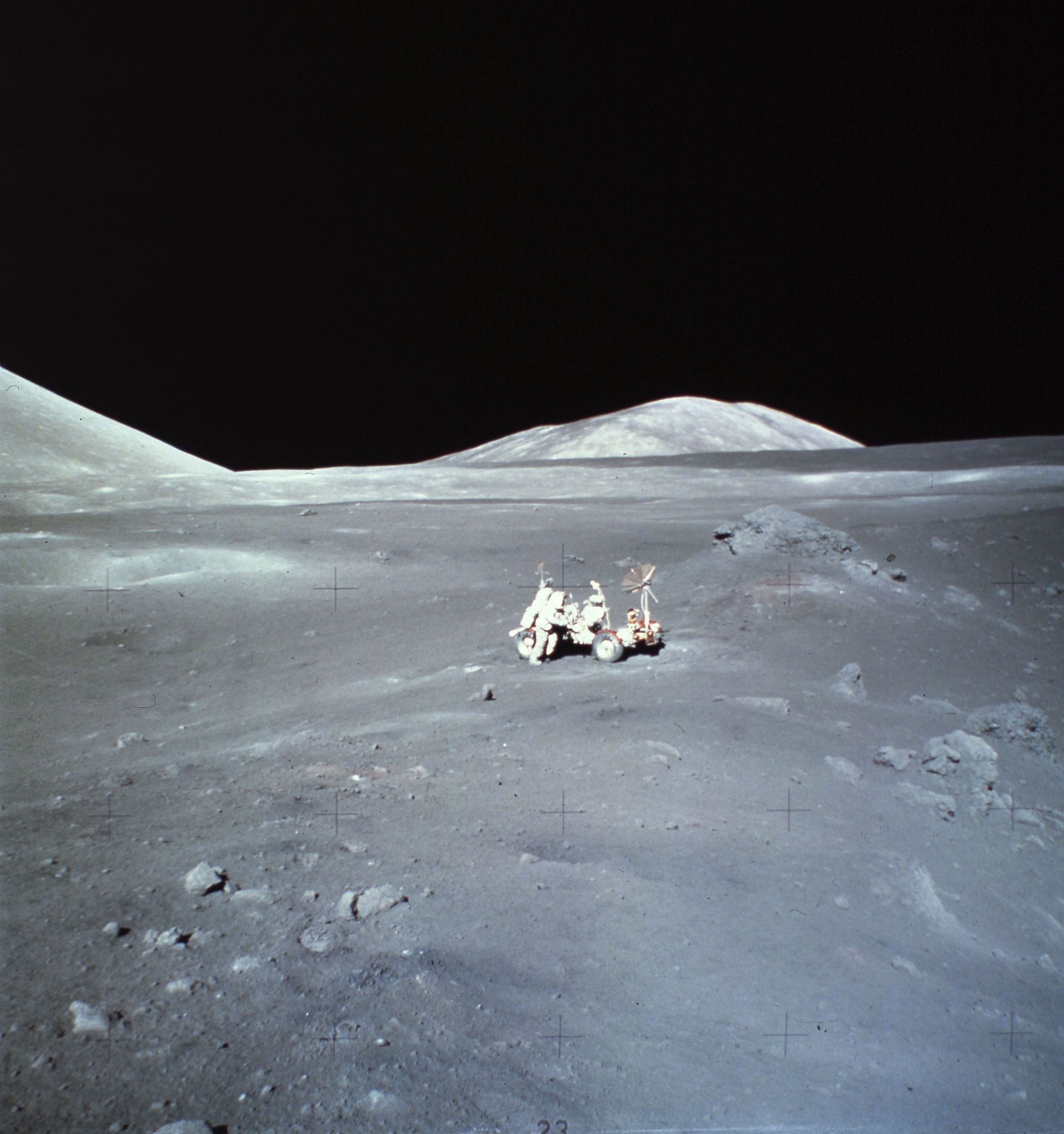
Apollo 17 - the final mission to the Moon in 1972
Apollo 17 - the final mission to the Moon in 1972
In 2017, Donald Trump signed a space policy directive to return American astronauts to the Moon, and on to “other destinations”. Nasa said it would aim to do this by 2028. But recently the administration directed the space agency to bring that forward to 2024, citing Chinese lunar ambitions. It hasn't gone unnoticed, however, that the date would coincide with the end of Trump's second term, should he be re-elected.
This time round, Nasa wants to do things differently. The Moon is part of a bigger ambition to explore deep space, including Mars, so part of the plan is to establish a lunar outpost.
“We're not going back to the Moon to leave flags and footprints and then not go back for another 50 years,” Nasa’s administrator Jim Bridenstine said earlier this year. “We're going to go sustainably - to stay - with landers and robots and rovers and humans."
But can Nasa safely mount a return mission by the deadline, given that critical hardware has neither been built nor flight-tested?
“It’s going to be risky,” says John Logsdon, professor emeritus of political science and international affairs at George Washington University in DC. But he adds: “If we’re not willing to accept a certain level of risk, then we should stay on the ground. The issue is balancing risk with activity.”
The human factor
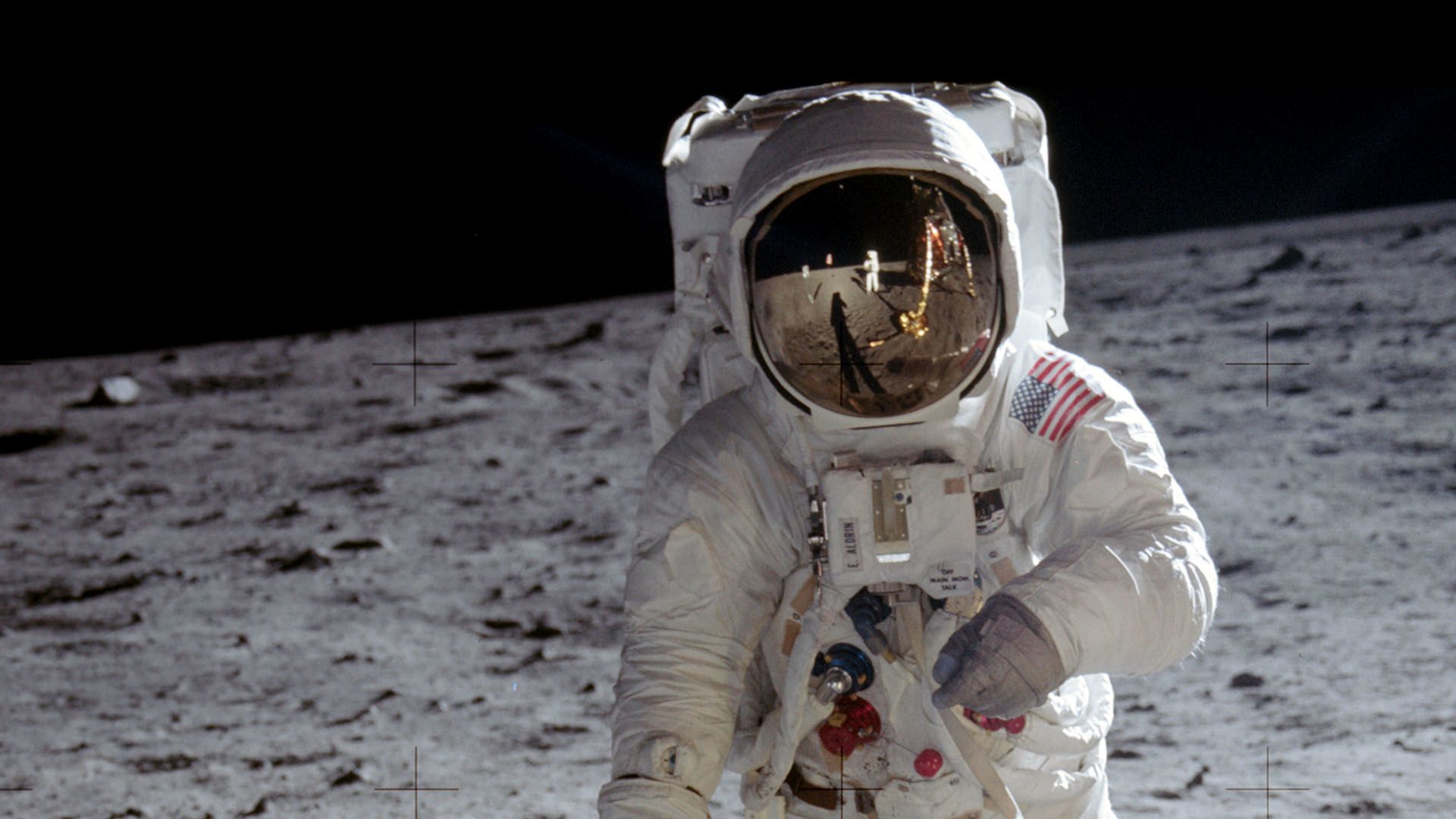
Previous Nasa lunar missions have been named after the Greek god Apollo. The next will be named Artemis after his mythical twin sister, and there is already speculation about the identity of the agency's first female Moonwalker.
Nasa has 38 active astronauts, 12 of whom are women. They include Kate Rubins, a microbiologist who has studied some of Earth’s deadliest diseases; Jeanette Epps, a former CIA technical officer; Serena Aunon-Chancellor, a doctor; and Christina Koch, an electrical engineer.
Jim Bridenstine recently told CNN: “It will be somebody who has been proven, somebody who has flown, somebody who has been on the International Space Station already.”

Stephanie Wilson has the most flight experience, having been on three shuttle missions. Tracy Caldwell Dyson and Sunita Williams, have each logged two flights.
“As it is now, we demand more when you're looking at functional performance of an astronaut, than we ever have in history,” says Michael Barratt, a Nasa astronaut and honorary professor at the University of Exeter Medical School, UK.
“The astronaut of today flies a multi-national vehicle for six months and has to be uber-trained, basically, in spacewalking, robotic arm operation, all sorts of systems, has to be functionally bilingual in English and Russian, and cope with isolation and confinement for six months at a time.”
But what additional challenges will they face beyond Earth’s orbit?
We already have a good understanding of the changes that occur to the human body in space. “I like to say that we literally become extra-terrestrials,” says Barratt, who is also a medical doctor. “Your anatomy changes, your physiology changes, your biochemistry changes. And we still function right along, it really is quite remarkable.”
Astronauts will face hazards working on the lunar surface. “Though it's only one-sixth of Earth’s gravity on the Moon, you're going to be wearing a very heavy suit, carrying tools and implements and excavating, climbing, digging, and exploring. That's what really adds its own set of risks,” Barratt says. Astronauts could break bones in a fall, or put a pick through their spacesuit.
Then there’s the issue of dust from the lunar surface. The Apollo astronauts experienced episodes of coughing and, in some cases, breathing problems when dust became airborne inside their spacecraft. A way to control that will need to be found.
Radiation poses one of the biggest challenges. Outside the protective magnetic bubble surrounding Earth, astronauts are exposed to roughly three times the radiation dose per day they receive in low-Earth orbit. It contributes to an increased risk of long-term problems such as cancer and cardiovascular disease.
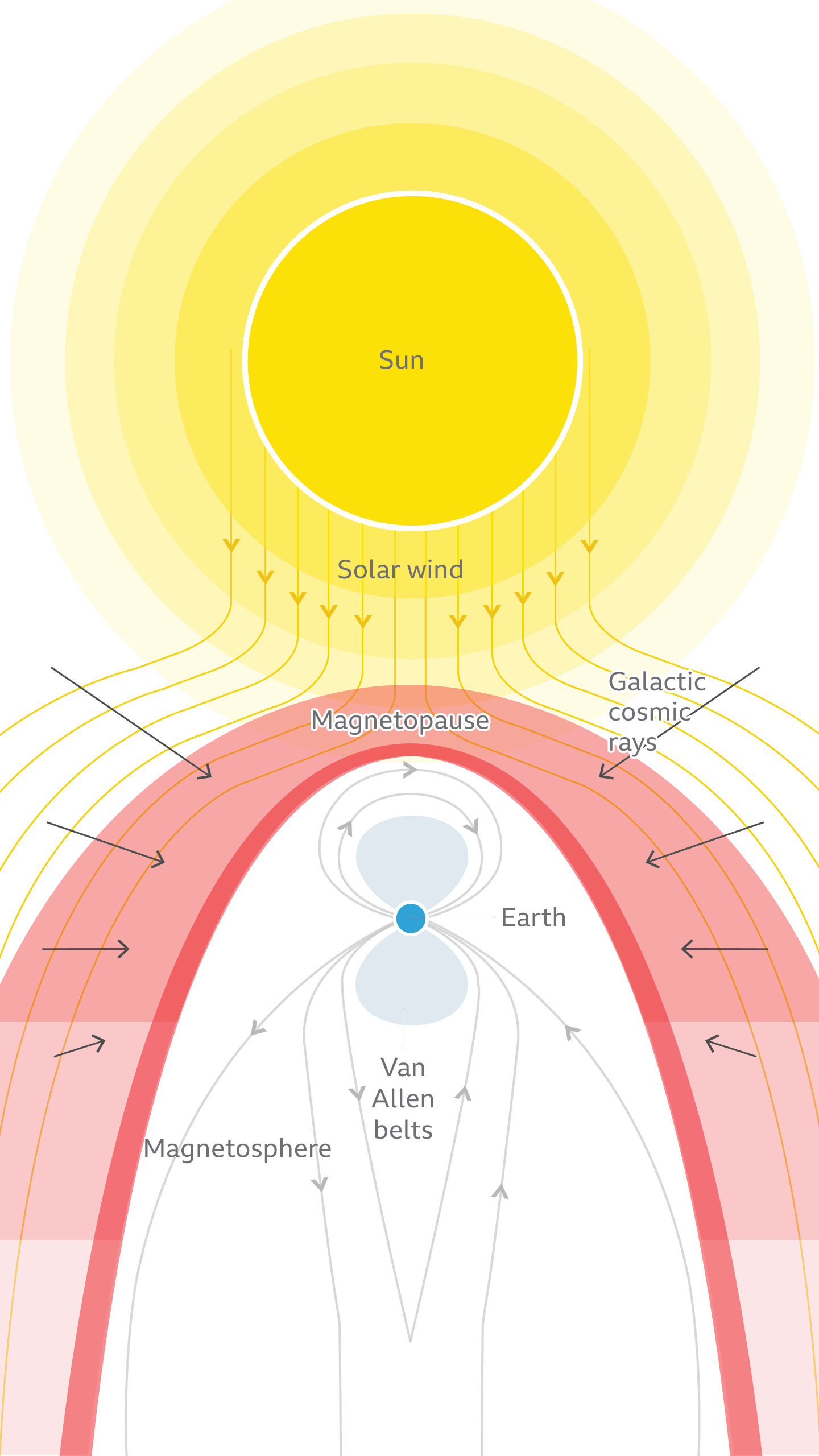
The radiation comes from several sources. Galactic cosmic rays (GCRs) have lots of energy, but there are few of them. The Van Allen Belts around Earth contain trapped sub-atomic particles, but exposure to these is temporary. However, ways need to be found to protect against solar particle events (SPEs) - where the Sun periodically hurls electrically charged particles into space.
Nasa’s next-generation ship, Orion, uses materials within its structure to shield the occupants from radiation.
Orion
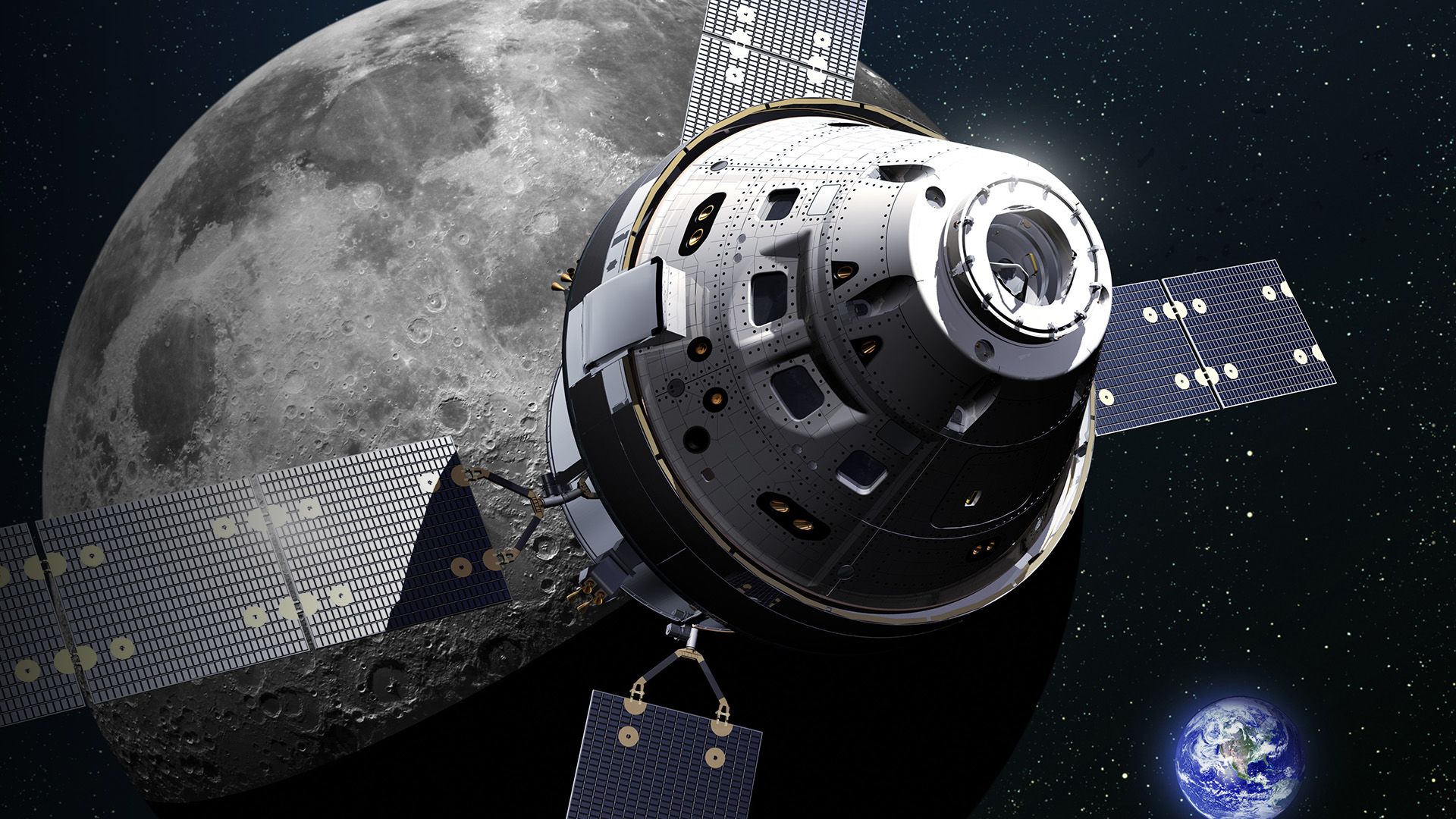
The cornerstone of America’s plan to return to the Moon is the Orion crew module. Its conical contours recall the Apollo command modules, rather than the spaceplane stylings of its immediate predecessor, the space shuttle. To many people, the spacecraft evokes a golden age of space exploration, when anything seemed possible.
But the 10-tonne spacecraft makes use of technology unimaginable back in the 1960s, and even the methods being used to build it are innovative. At Lockheed Martin, which is building Orion for Nasa, engineers have been equipped with augmented reality (AR) headsets.
“You’re looking through a lens that’s a see-through visor, but then you have these digital objects that are overlaid in the environment,” explains Shelley Peterson, emerging technologies lead at Lockheed.
By using instructions superimposed over a view of the real world, technicians can easily determine where to drill a hole, or mark the location of a cable fastener. This also means that they don't have to refer to a manual that might run to thousands of pages, enabling them to work quicker and more efficiently.
“We had a person on Orion who was near retirement,” says Peterson. “He was expressing that he might push out his retirement so he could experience it on the shop floor.”
Compared with Apollo, “Orion is much more dense in terms of its capabilities per cubic foot,” says Rob Chambers, senior manager systems engineering at Lockheed Martin. “That’s one of the reasons it was complex to design and build.”
Orion was originally part of President George W Bush’s plan to return to the Moon, which was announced in 2004. When that programme was cancelled in 2010 under the Obama administration, it was the only element to survive.
Orion’s four flight computers can run pretty much everything on the spacecraft without intervention from humans, making the spacecraft very self-sufficient. In this respect, says Chambers, Orion is a “real generational step-up”.
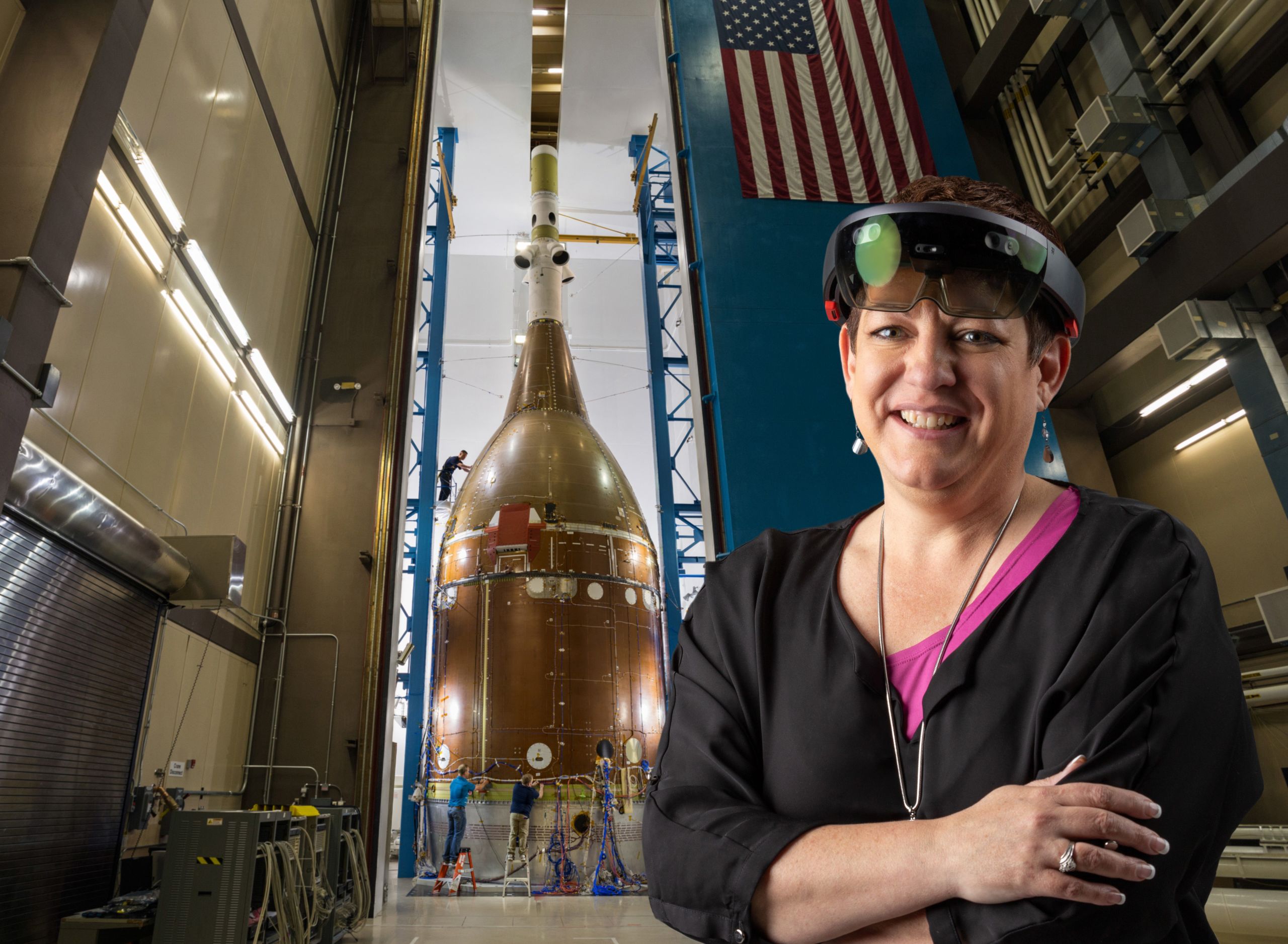
Shelley Peterson
Shelley Peterson
The computers are of a type built for Boeing’s 787 commercial airliner. But they have been toughened up for the rigours of space travel, where G-forces, vibration and radiation can damage delicate hardware. “That’s why we have four sets of flight computers, it’s not because we expect them to burn out through electrical failure. It’s to handle that deep space environment,” Chambers adds.
The computers aren’t the most up-to-date ones available. With space travel, tried-and-tested hardware is preferable to something that’s more innovative but less well-understood.
The outside of the spacecraft also needs to be tough. Orion is designed to take hits from small space rocks, or particles of human-made debris in orbit around Earth.
If a breach were to cause Orion to lose its air, the spacecraft has to be able to get back home. Astronauts will be supplied with pressure suits to keep them alive in a vacuum. But the electronic systems (avionics) have been specially designed to lose heat without fans blowing air over them.
When Orion returns to Earth, the largest heat shield ever built will protect the crew inside from the temperatures of 2,760C (5,000F) it could experience during re-entry to the atmosphere. The heat shield will use elements of thermal protection systems used on the space shuttle and robotic missions to Mars.
As it falls towards the ground, Orion will deploy a total of 11 different parachutes – most of which are made from a hybrid of Kevlar and Nylon - to slow the vehicle down to the speed of 27 km/h (17mph) required to safely splash down in the Pacific Ocean.
An amphibious transport ship will be waiting nearby to retrieve the astronauts. The ship then tows Orion onto a flooded well deck and lifts it into a recovery cradle for the journey home.
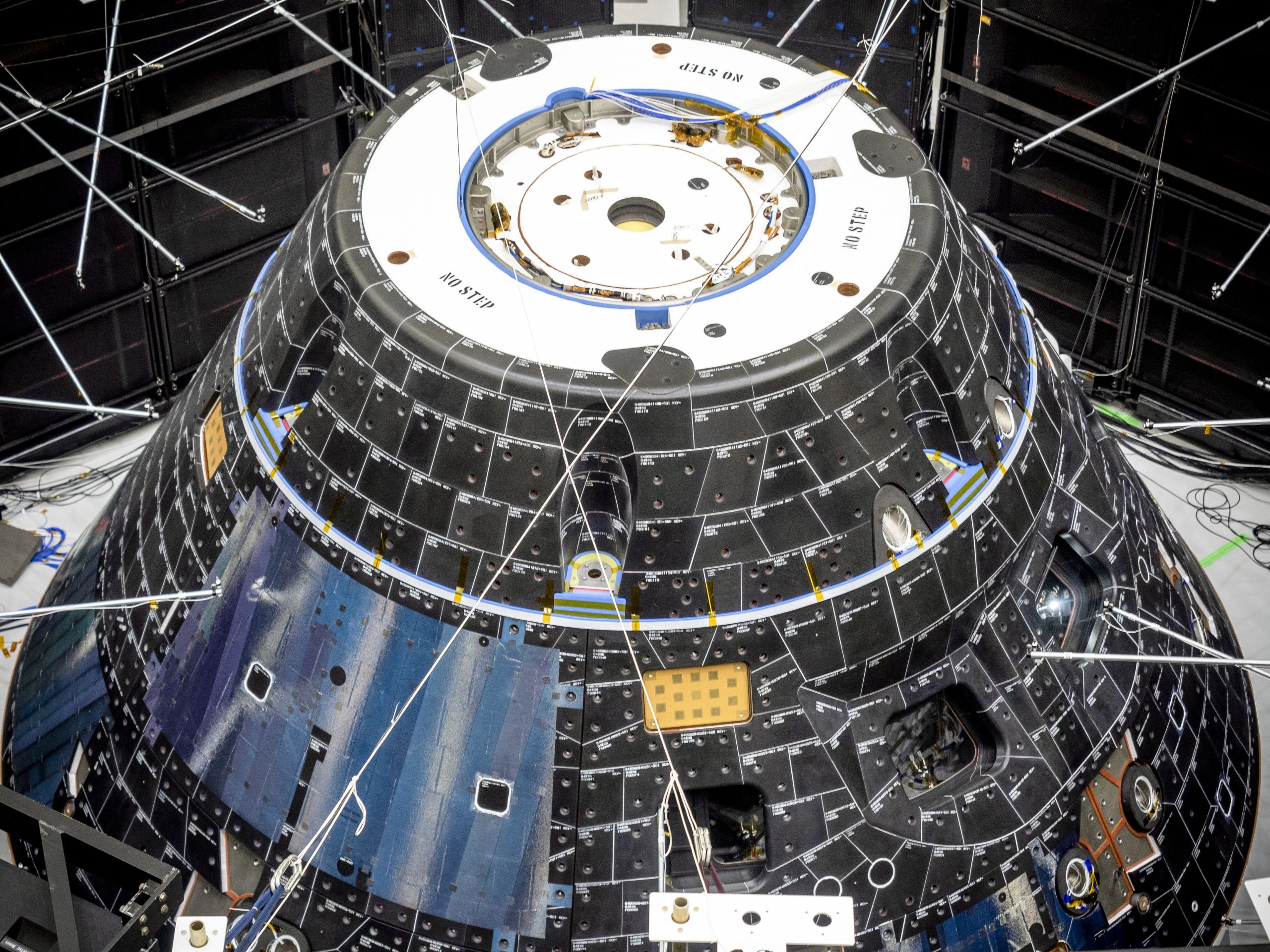
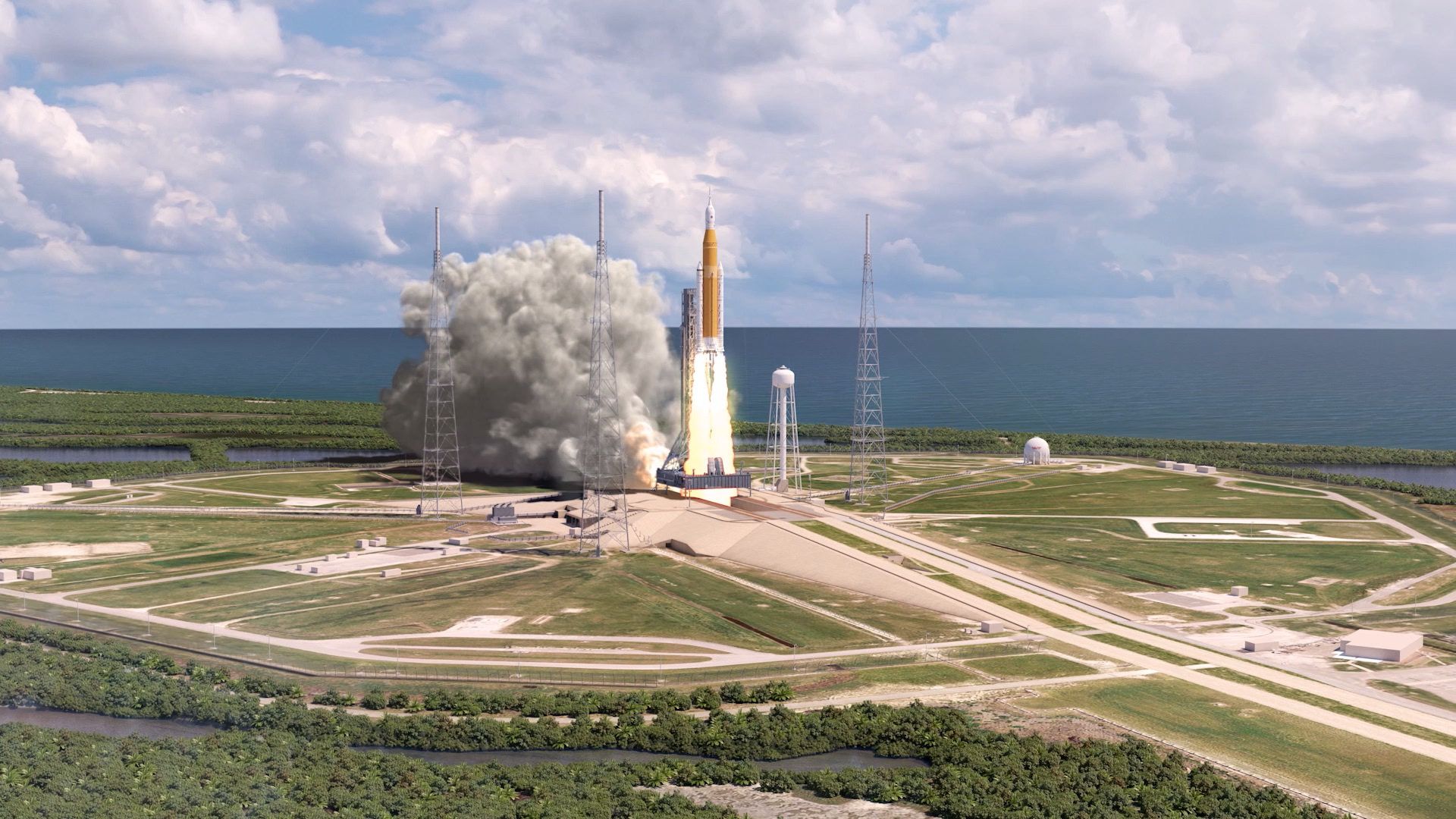
Orion is one big part of the Moon return plan. Another is the rocket that will carry it into space. The Space Launch System (SLS) is taller than a 30-storey building and will be able to launch payloads of up to 130 metric tonnes – the equivalent of 10 of London's New Routemaster buses.
“It is truly an immense rocket. It is just jaw-droppingly big,” says John Shannon, vice president and programme manager for the SLS at Boeing, which is building the rocket for Nasa.
The SLS re-uses technology developed for the space shuttle. But the new rocket is a completely different beast. The huge core stage is based on the external tanks that fed propellant to the shuttle’s main engines. Its two solid rocket boosters are also modified shuttle elements.
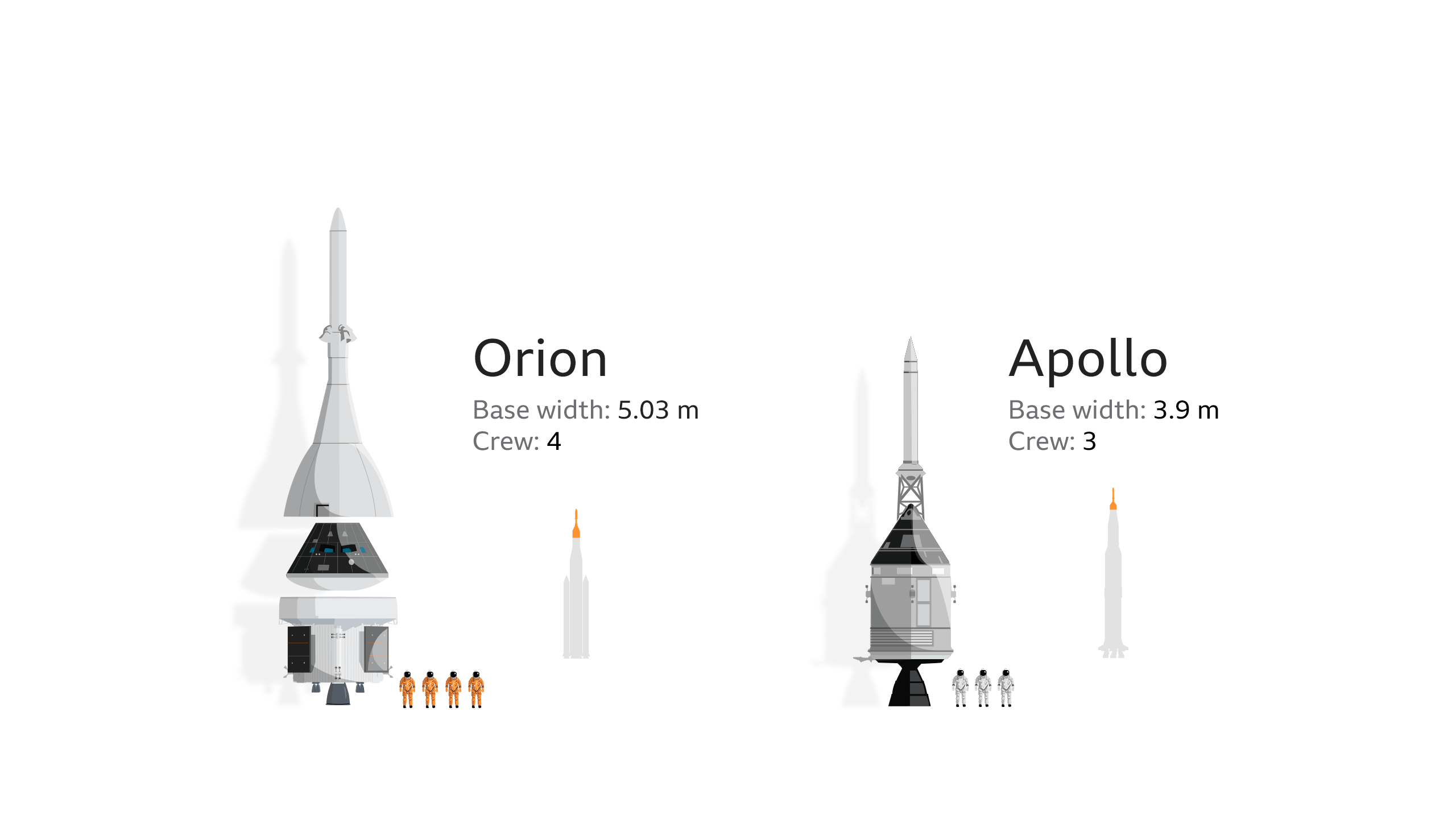
But this created challenges, because the SLS exerts very different levels of stress on components. “We took some of the hardware from the space shuttle and put it in that environment and it did not survive,” Shannon explains. “We had to go back and do significant re-designs in a number of instances.”
One of the big challenges was ensuring the rocket’s engine section could cope with shaking from the powerful solid rocket boosters. Engineers had to take individual components and “qualify” them, proving they could survive the vibration.
The engine section gets very hot during flight, so engineers are insulating it with sheets of cork - the very same stuff you’d find in the neck of a wine bottle. Cork is full of air spaces, making it one of the best thermal insulating materials available.
Developing it has cost about $12.5bn (£10bn), and a government oversight report released in June detailed cost overruns totalling $1.8bn.
John Shannon believes things are now looking up. “We’ve been through the hard part: the qualification and design of the hardware,” he says. “We’re at a great point right now, the factory is humming, we’ve got our first vehicle, it will roll out of the door by the end of this year.”
Its maiden flight is expected to take place no earlier than June 2020.
But not everyone thinks this is the best way to go. There are those who think it would be best to launch on commercial rockets like those being developed separately by billionaire entrepreneurs Elon Musk and Jeff Bezos.
Robert Zubrin, from Colorado-based company Pioneer Astronautics, has come up with a plan called Moon Direct which would use less powerful commercial rockets to launch a versatile spacecraft to the Moon.
Zubrin believes that with two launches a year at a cost of $1bn (£800m) each, the SLS could be put to much better use, such as pushing on to Mars.
John Shannon says his team “knows what they’re doing, how unique it is - and how difficult it is,” adding: “I suspect that once SLS is in the national capability, there won’t be a need for another heavy-lift vehicle like it for many years. So this is really a once-in-a-generation opportunity.”
Lunar Gateway
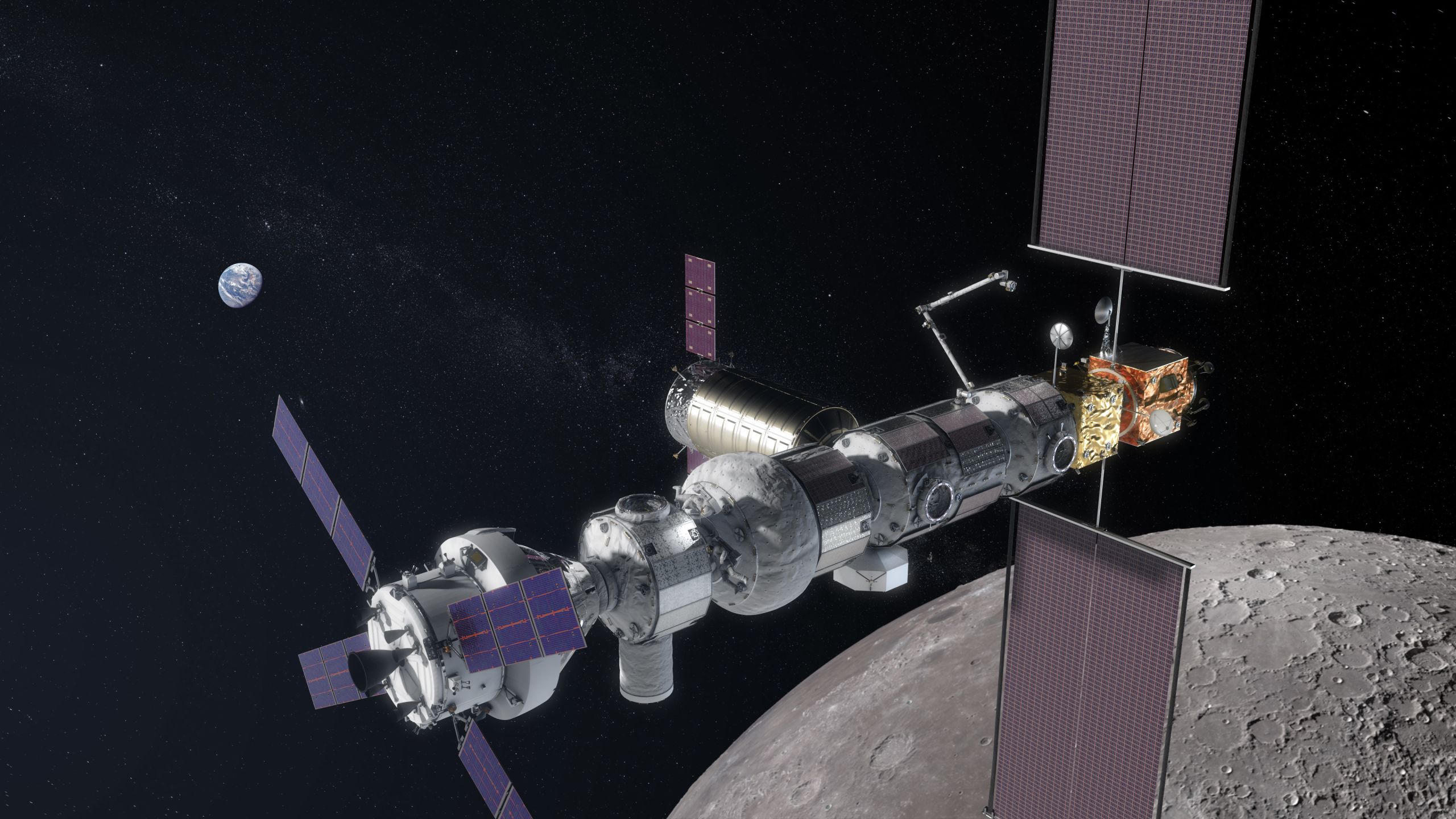
Why is the US building a space station in lunar orbit? It seems like a legitimate question, given that astronauts got along just fine without one 50 years ago.
“The purpose of the Gateway is really as a waystation to get to the surface of the Moon and push on to Mars,” says Pete McGrath, director of global sales and marketing for Boeing’s space exploration division.
The company’s John Shannon could be described as the architect of Gateway. While working at Nasa around 2011, he was tasked with figuring out what was next in human exploration. “I sat down and went through every single design reference mission Nasa had produced for the last 20 years. It was a stack four feet tall,” he says.
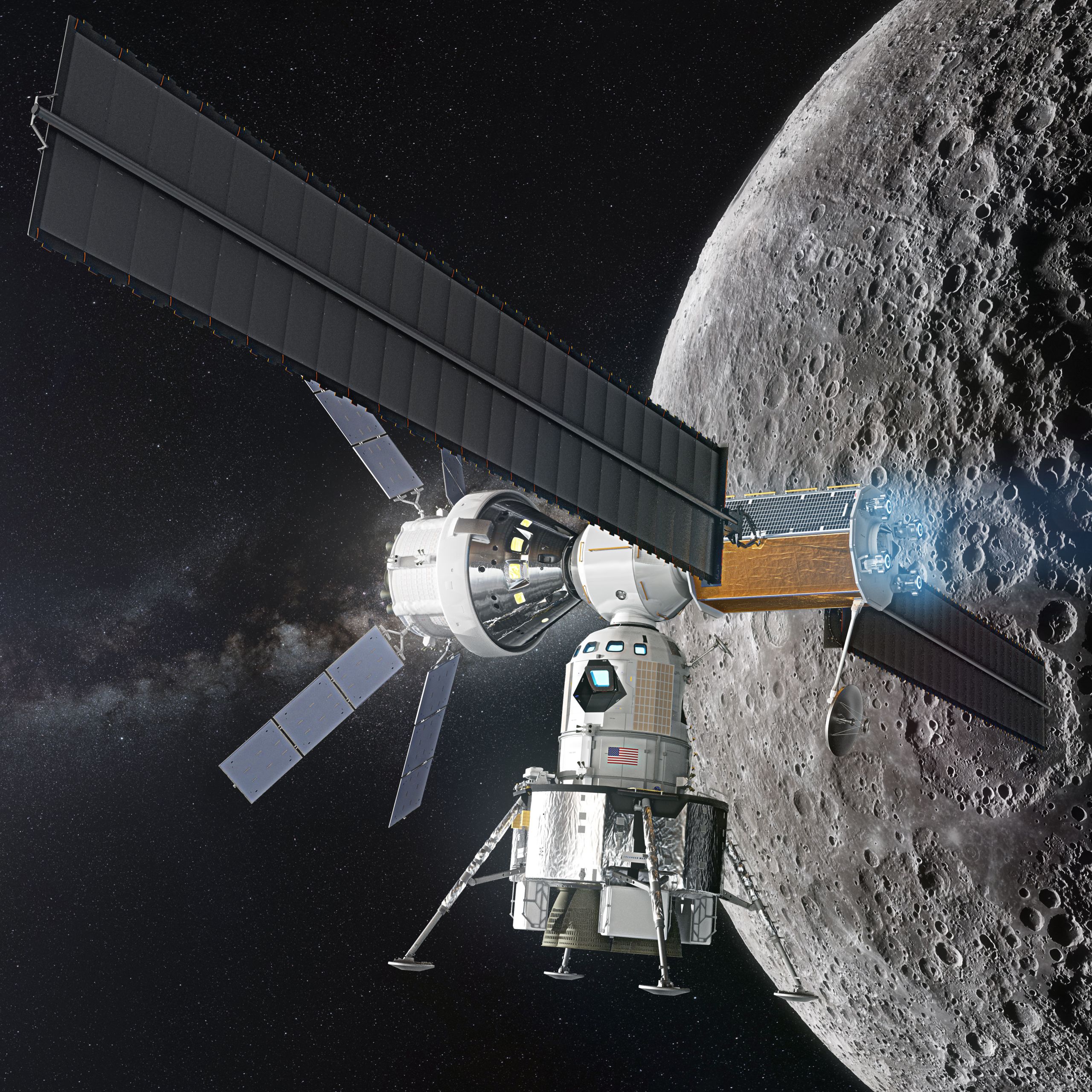
A basic version of Lunar Gateway could be operational by 2024
A basic version of Lunar Gateway could be operational by 2024
Shannon started to focus on ideas that were viable. “What made a lot of sense was the ability to build a very small crew-tended space station around the Moon,” he says. “Gateway gives you a place for crews to get set up before they go down to the surface. It gives you an opportunity to control remote vehicles on the surface.” It would also act as a safe haven were anything to go wrong during a mission.
The Apollo missions took all the hardware necessary for completing the mission with them to the Moon. Nasa put them on a path around the Moon called a free return trajectory, which would get them safely back to Earth if, for example, an engine didn’t fire to send them into lunar orbit. But this limited them to landing in a narrow band around the equator.
Gateway will be higher up, in an oval-shaped path around the Moon called a Near Rectilinear Halo Orbit (NRHO), giving Nasa the ability to land wherever it wants.
“That means you have to stage further away from the Moon, so you can make your decision there as to: ‘Do I want to go to the poles or do I want to go to the equator?’” says Chambers.
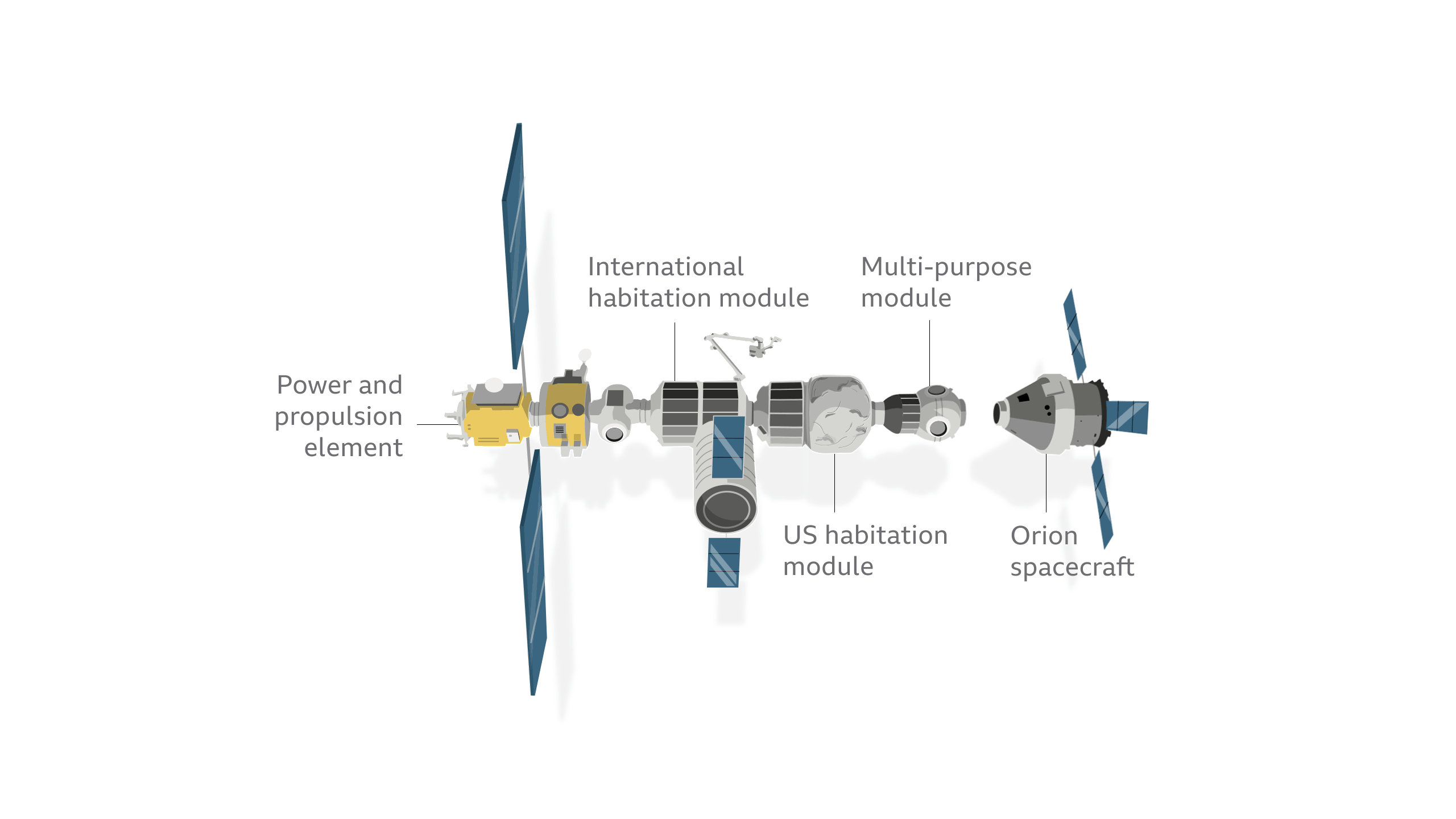
The station won’t be complete in time for the 2024 mission. But Orion could dock with a stripped-down version, consisting of a power and propulsion module and a small habitat for crew.
Eventually, says John Shannon, Gateway “could be a place where you aggregate all the logistics you needed for a Mars transfer vehicle”.
The outpost remains controversial. Dr Robert Zubrin, author of the book The Case for Space, sees it as an unnecessary stop on the way to the Moon, and refers to it as a lunar orbit tollbooth.
But John Logsdon of George Washington University says: “If all you wanted to do was land at the South Pole of the Moon, I’m not sure Gateway is essential. But the plan calls for an initial landing in 2024 and a sustainable programme by 2028 – first to the Moon and then to Mars. If you’re going to do that programme, then Gateway is an important element.”
Boots on the Moon
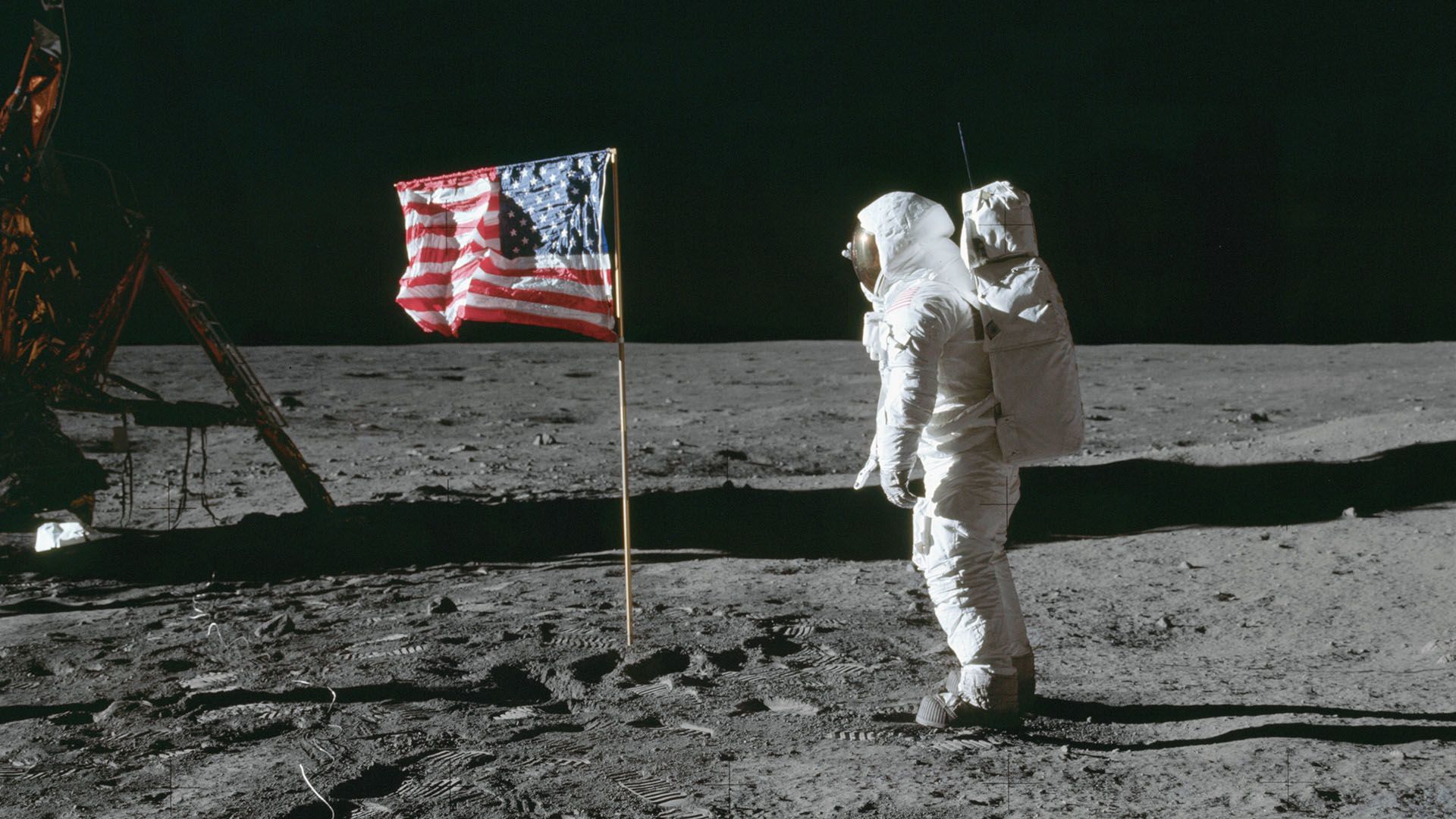
It was arguably the defining event of the century. On 20 July 1969, Neil Armstrong and Edwin “Buzz” Aldrin were fast approaching the Moon’s surface in their lunar module (LM) spacecraft. For reasons unknown, the LM was veering off course, four miles downrange of the intended landing site.
During the final 2,000 feet (610m) of the automatic descent, Armstrong looked out the window and saw the LM was heading for a large crater surrounded by boulders as big as cars. Landing here would have been catastrophic.
As the LM approached the 500-foot (152m) mark, Armstrong assumed manual control of the spindly craft and flew it like a helicopter. He piloted the LM over the crater and the boulders, landing safely on a flat plain.
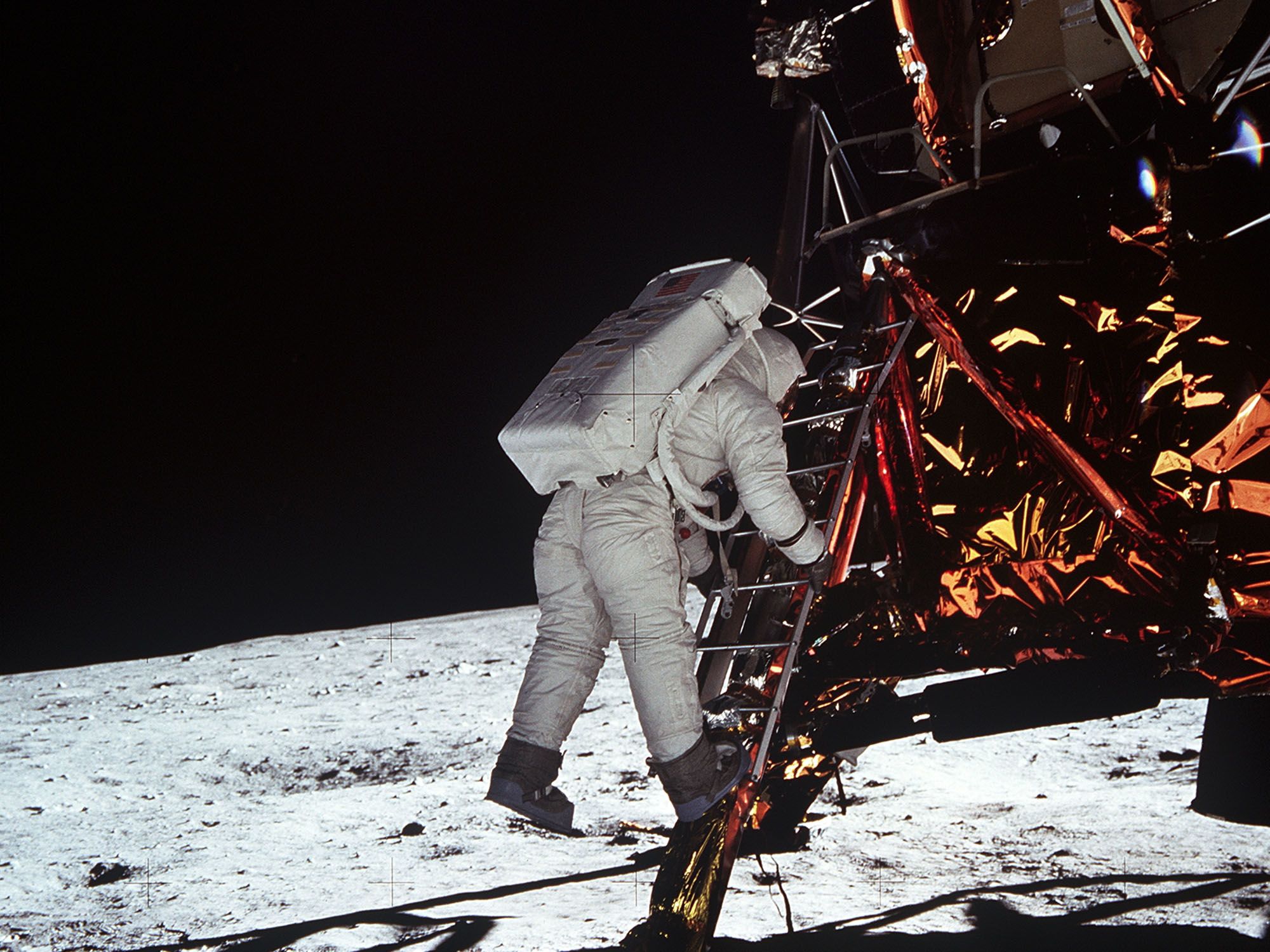
Future landings will need to be safer and more precise.
“You’re going to need much more capable autonomous landing systems,” says Ken Gabriel, chief executive of Draper in Boston. “That means the ability to do things like terrain feature navigation, where the way you know where you are on the Moon is to look at, in real-time, and process the scenery that you’re seeing through the camera systems of the landers.
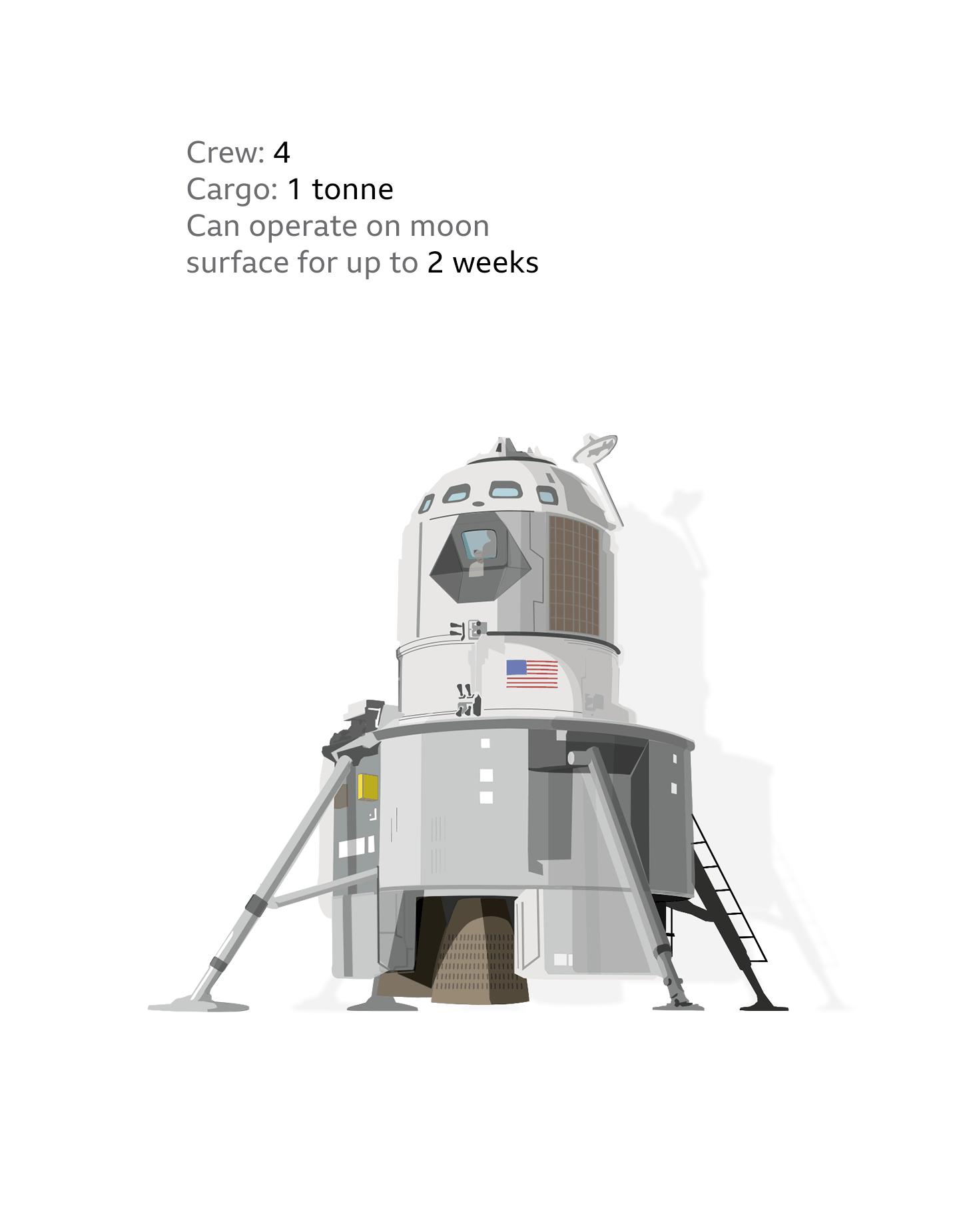
“You need to not only recognise where you are but, with sub-metre accuracy, figure out where you’re going to be and how to avoid obstacles as you get close. All the things that Neil Armstrong did with his eyes and his brain and his hands when he was landing on the Moon, we’re going to have to invest that capability into autonomous landers.”
Landing at the South Pole of the Moon will be a thrilling spectacle. When astronauts venture outside, they might be wearing spacesuits like the Z-2 prototype. It’s designed to give the wearer greater mobility than previous suits, allowing explorers to go uphill and downhill, and bend over to pick up rocks.
Lifting off from the Moon could be challenging. “When you're launching from the Earth, you're launching from a fixed and known launch site,” says Dr Seamus Tuohy, from Draper Lab.
On the Moon, he explains, everything depends on where you’ve landed and how the vehicle is sitting.
The lander, which for 2024 hasn't been built, perhaps sums up better than any element the anxiety felt around the accelerated timeline. There’s no hardware to speak of yet, and it remains unclear how it will be tested before 2024.
But Robert Zubrin argues that five-and-a-half years is enough time to build and test the lander.
“Gateway itself is sapping funds from the development of a lander, which you actually do need if you want to land on the Moon,” he says.
Economy
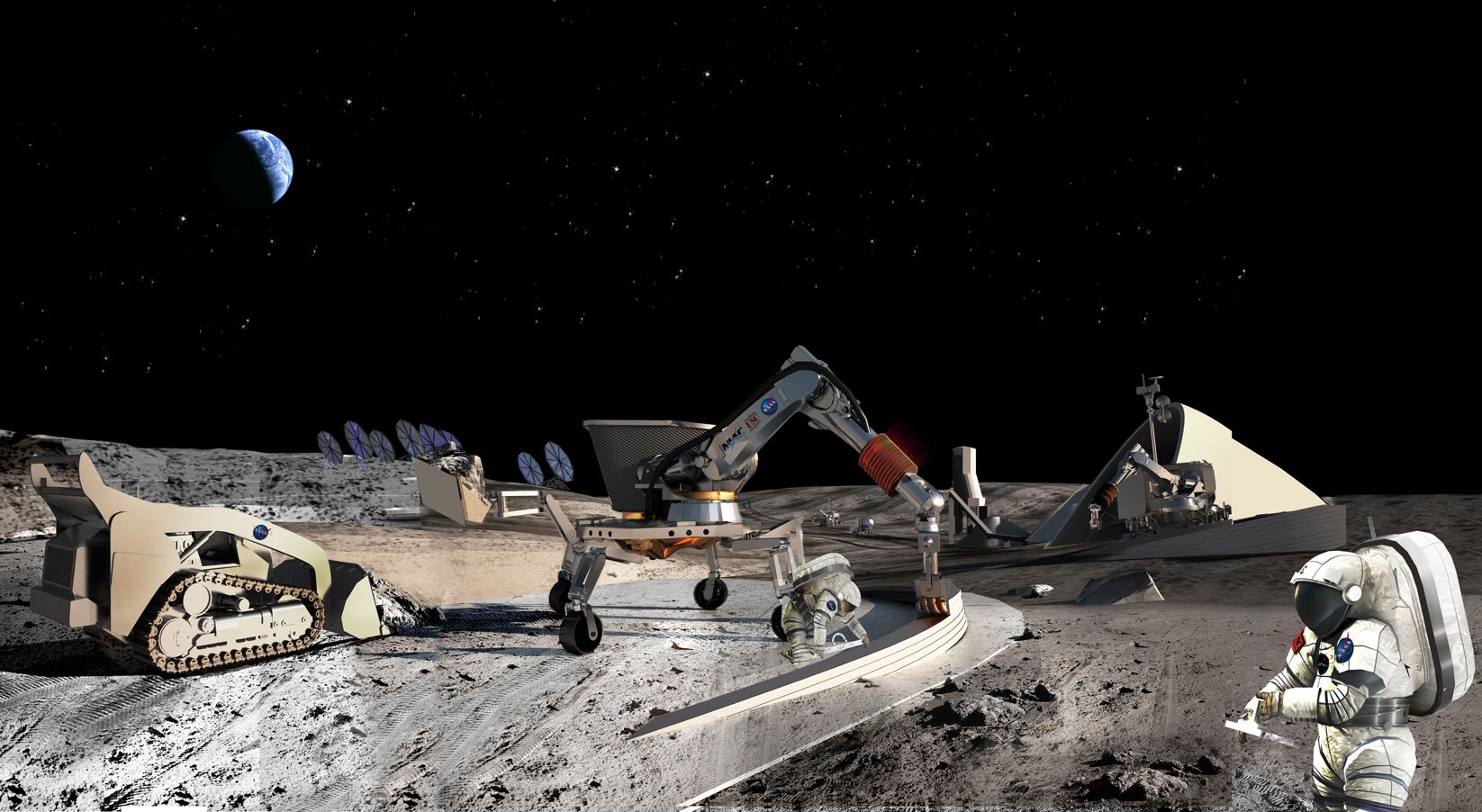
It's not all about landing on the Moon, some people are already getting ready for a lunar economy.
Space company Astrobotic says it's building a "railroad" to the Moon. It's one of a number of companies that want to transport items to the lunar surface.
The railroad metaphor seems particularly apt for a company with its headquarters in the former heart of American steel manufacturing, Pittsburgh.
For a price, starting at $450 (£358) for small items such as keepsakes and rising to $1.2m per kg for heavier items such as robot rovers, Astrobotic will deliver the payload of your choice to the Moon, using its four-legged Peregrine robot lander. Astrobotic’s customer manifest includes time capsules, science instruments, a rock from Mount Everest and a token from Kennywood, a well-known Pittsburgh amusement park.
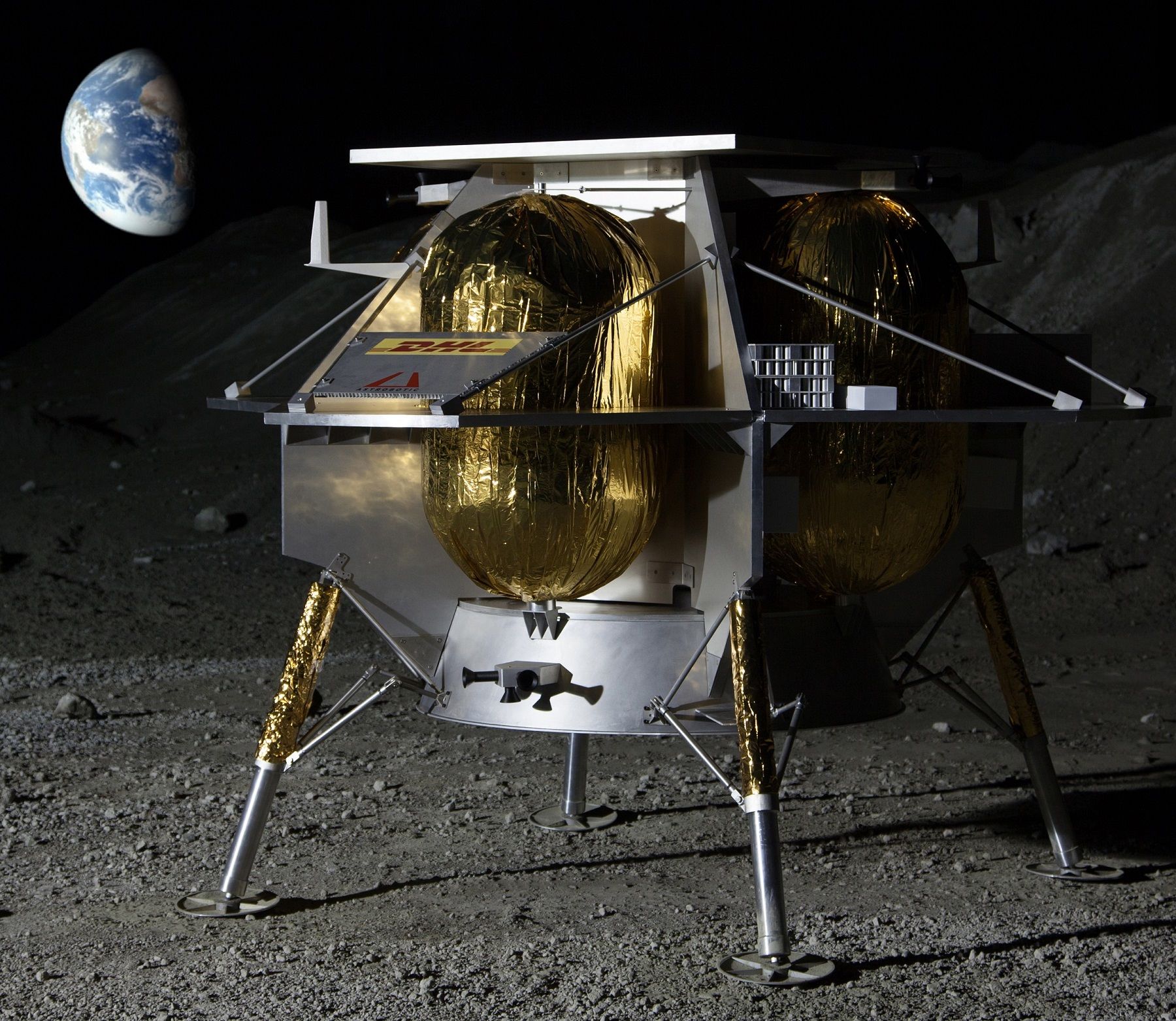
Astrobotic lander
Astrobotic lander
By providing end-to-end delivery services for private customers and Nasa, companies like Astrobotic could make the first steps towards building a sustainable lunar economy.
“We can have providers in space making rocket fuel, making other materials, providing services. Then Nasa’s investment, or Esa’s investment doesn’t need to cover the entire cost of that infrastructure,” says Dr Philip Metzger, a planetary scientist from the University of Central Florida in Orlando.
Tourism is likely to be another early lunar revenue source. In 2018, Elon Musk’s company SpaceX unveiled the first private passenger it plans to fly around the Moon in 2023. That date will probably slip, but a Japanese billionaire has paid an undisclosed amount to go there on Musk’s cheekily-titled Big Falcon Rocket (BFR) vehicle.
Further into the future, tourists could land on the lunar surface and stay in habitats. UBS estimates that space tourism will be a $3bn (£2.3bn) market by 2030.
But mining water-ice for rocket fuel is likely to be the foundation of a lunar economy. These deposits are concentrated at the North and South Poles, where the interiors of some craters never see sunlight. Never exposed to enough heating to boil them away, deposits of water-ice – perhaps billions of tonnes – persist in these shadowed craters.
Re-fuelling vehicles at the Moon could bring down the cost of space travel and make a lunar outpost more affordable. A 2018 report suggests rocket propellant could be produced at a cost of $500 per kg on the lunar surface. That’s 20-times cheaper than the $10,000 per kg projected cost of transporting it from Earth to lunar orbit.
Lunar propellant could also be used to boost satellites from low-Earth orbit (LEO) to a higher, geostationary orbit. A spacecraft carrying fuel from the Moon could rendezvous with a satellite in LEO and use the propellant to push it to its final orbit. This could save around $100m (£79m) per spacecraft.
However, Dr Paul K Byrne, from North Carolina State University in Raleigh, says a lunar economy will take time to develop. “We can see where we want to go. But it's got to be decades before this is even remotely commercially viable,” he says. “Until then, it's going to be something that governments have to bankroll.”
Lunar living
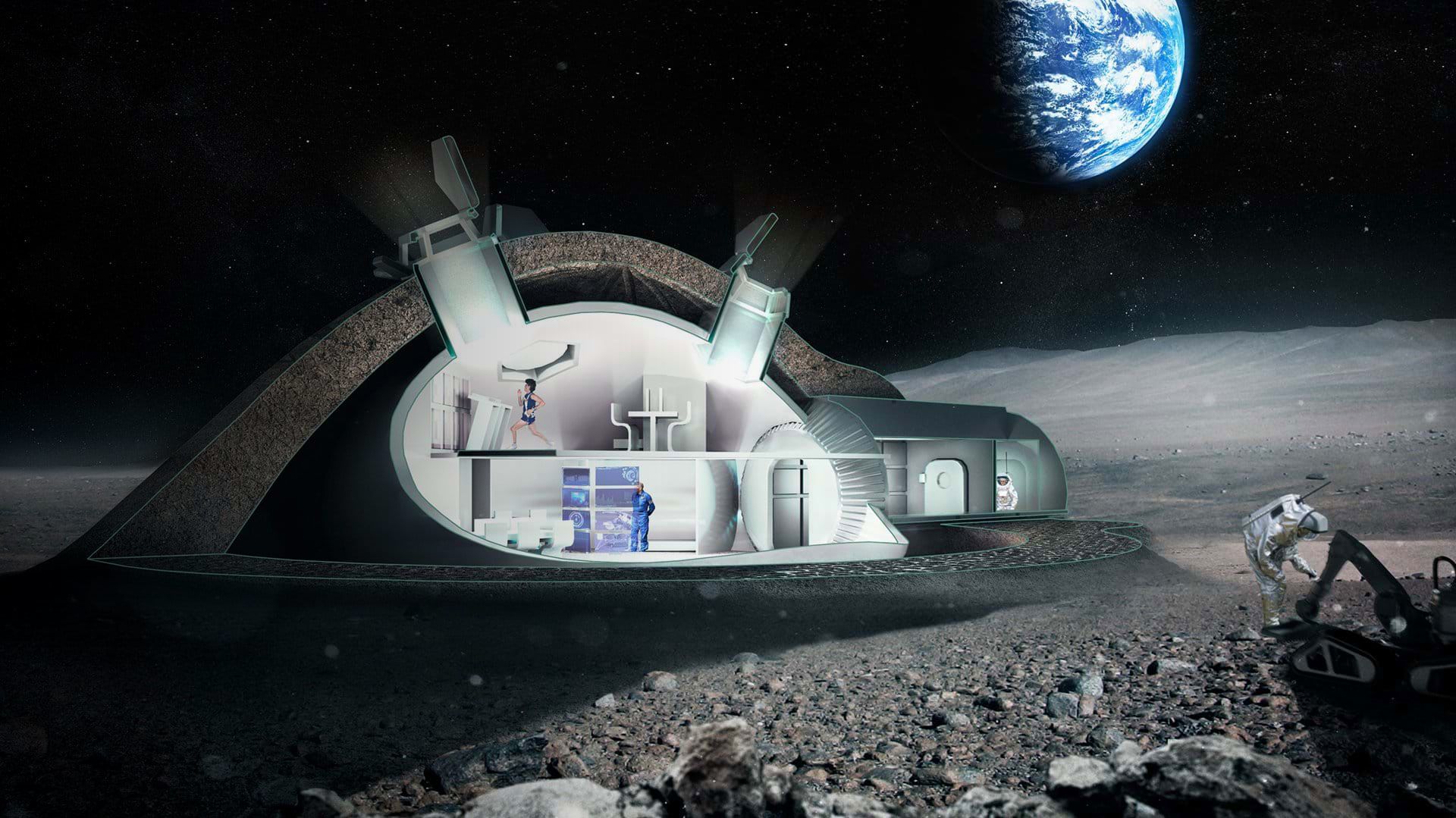
The Artemis plan culminates with the deployment in 2028 of a Lunar Surface Asset - in other words, a base. In the early stages of settling the Moon, inflatable modules made from multiple layers of fabric might be the best option.
They can be collapsed, taking up less space in a rocket than rigid modules, and provide more living space when expanded. The European Space Agency, along with UK architects Foster + Partners, have come up with a hybrid design. Their habitat consists of an inflatable, two-storey living space and a rigid module acting as an airlock.

Paul K Byrne
Paul K Byrne
To protect these habitats against micrometeoroid strikes and radiation, robots could 3D-print hard outer shells that could sit over the habitats. Lunar “soil”, or regolith, could even be used as the building material. “It’s an easy construction method, and can be done rapidly,” says Philip Metzger.
Longer-term, lunar settlers might move underground, setting up home inside natural tunnels in the rock called lava tubes. This would give them a ready-made shelter from radiation.
A prototype lunar greenhouse has already been developed at a University of Arizona facility in Tucson. Vegetables such as lettuce, tomatoes and sweet potato are grown under LED lights. It’s more or less a closed loop, where water is recycled. The plants contribute to life support systems because they scrub carbon dioxide from the air and produce oxygen.
A 12-wheeled prototype “truck” - the Space Exploration Vehicle (SEV) - has been designed by Nasa to help the astronauts get out to explore.
Before water can be extracted, there will be some prospecting to do. Once promising deposits have been identified, robots could be used to dig them up.
Philip Metzger thinks you could just heat the lunar soil so that the water is released as a vapour, so it can then be collected.
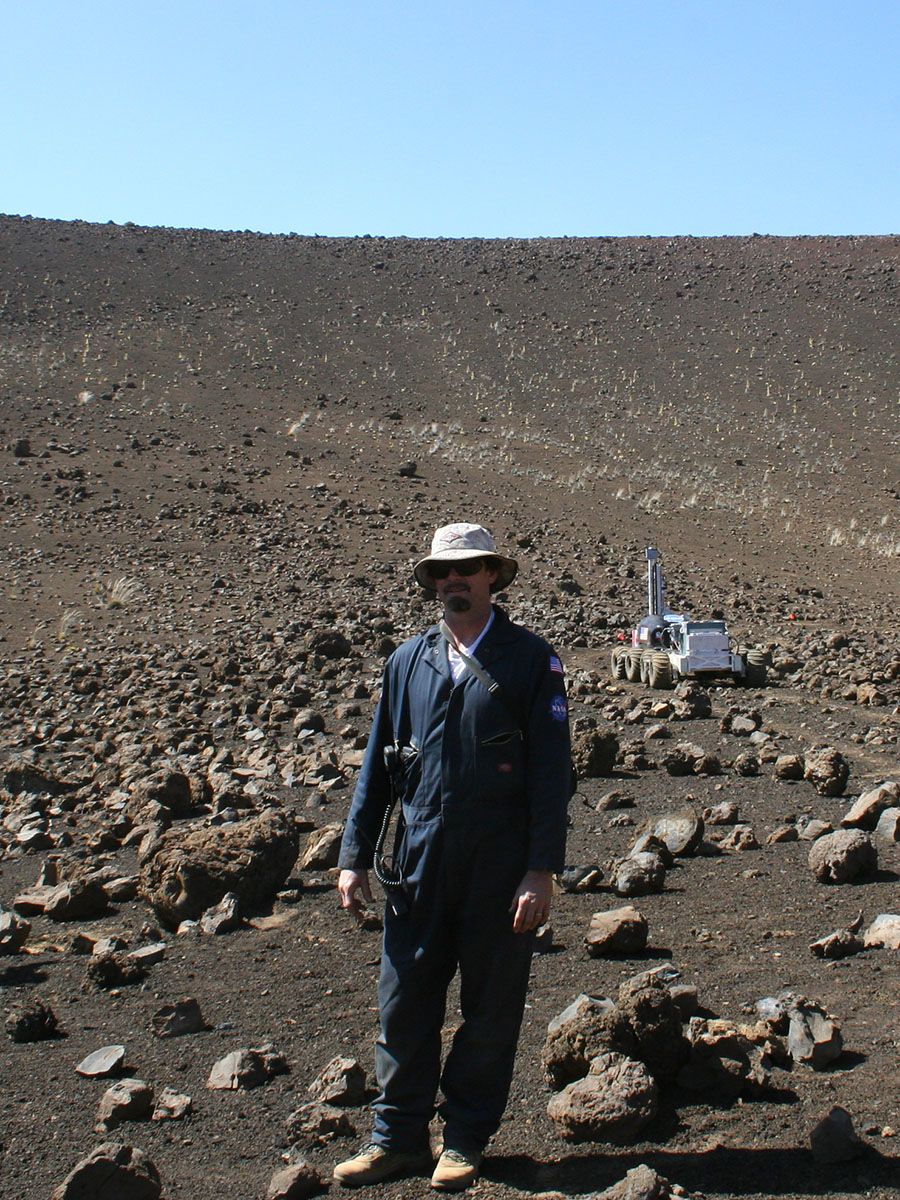
Philip Metzger
Philip Metzger
Power will be an issue in permanently shadowed craters. One way to get it in is by concentrating sunlight using mirrors mounted on a crater rim. “You take one of those mirrors and actively point it down at your rover,” says John Thornton, chief executive of Astrobotic.
Most of the water from mining would then be turned into rocket fuel using an electric current to split the water molecules into their constituents, hydrogen and oxygen.
Hannah Sargeant from the Open University is working on an instrument called ProSPA that aims to demonstrate water extraction from rocks on the lunar surface. ProSPA will launch in 2024 on a Russian robotic lander called Luna-27. Sargeant’s ilmenite experiment is a “breadboard model” that paves the way for a water extraction test on the Moon using ProSPA.
This kind of demonstration is vital. Paul K Byrne explains: “People are building all these projects that will figure out how you might do it. But deploying it and testing, I think, is the next critical step for this to happen.”
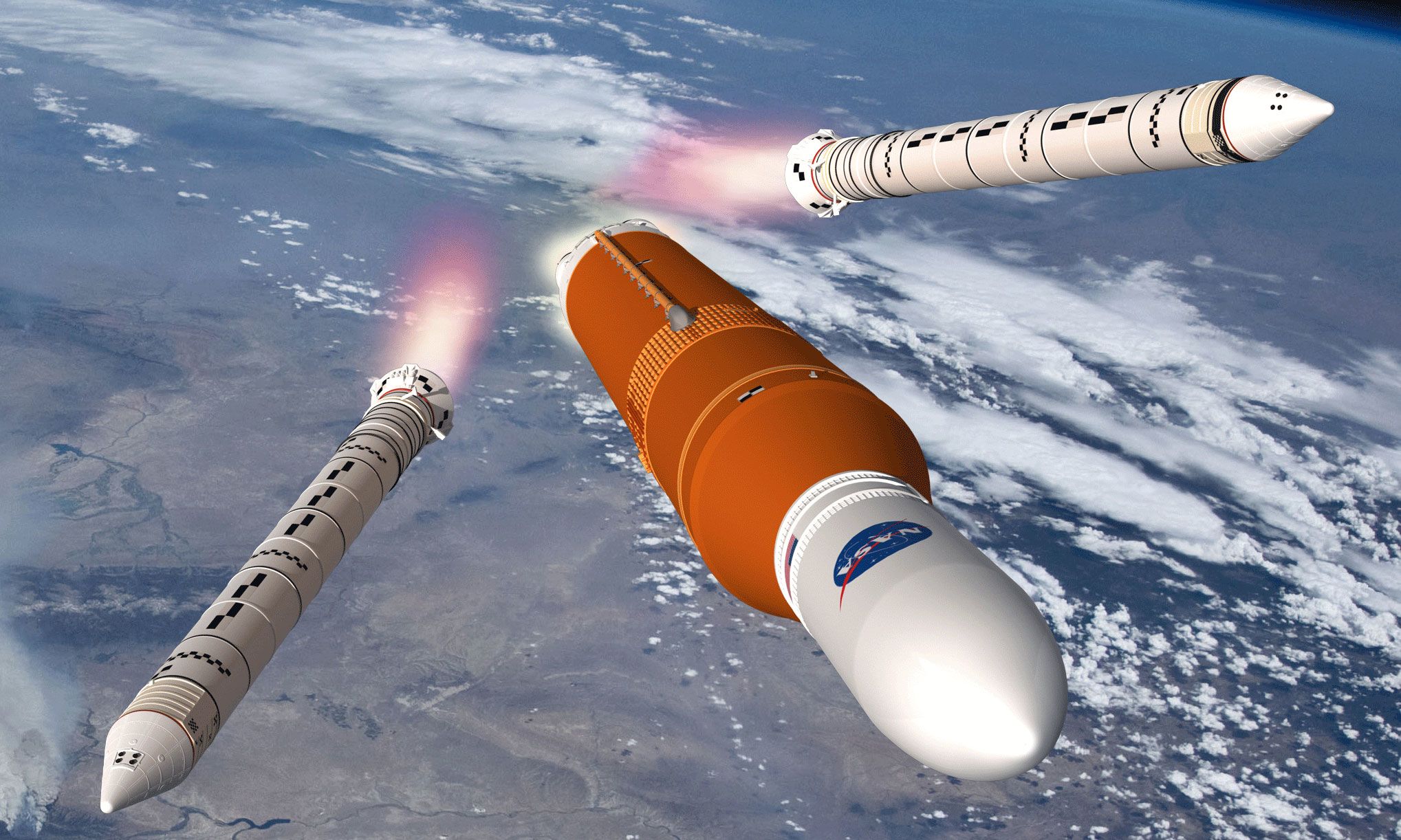
Fifty years on, the Moon landings remain a powerful symbol of what can be achieved when we mobilise our talents and resources to inspire. Rivalry with the Soviet Union gave the US a compelling reason to go, but it was fleeting. Once the space race had been won, Project Apollo continued for just six more missions before it was cancelled.
Time will tell whether 21st Century rationales for lunar exploration are more robust. “The single best reason to go back to the Moon, is to use it as a staging post to go beyond,” says Paul K Byrne, who cites Mars and asteroids as worthy targets for exploration.
In the past 15 years, Nasa’s destination has changed from the Moon, to Mars, then back to the Moon. “The road has been winding, but it’s aimed outward,” says John Logsdon. “I think it has been since January 2004, when Bush announced what became Constellation. It has been aimed at re-starting US human travel beyond Earth orbit.”
If Donald Trump were to lose the 2020 election, a new Democrat administration could cancel the Moon plan. But Logsdon considers this unlikely. “I think it’s much harder to think that a new government would cancel the return to the Moon programme, given how much momentum it’s building,” he explains.
However, the Moon programme will need more money. For 2020, the Trump administration has asked for $1.6bn in additional funding. But Nasa needs $6bn to $8bn per year on top of its existing budget to carry out Artemis. Congress will need to authorise those funds. A return to the Moon has support from both sides of the aisle, but many legislators are sceptical of the 2024 deadline.
The administration cited Chinese lunar ambitions while justifying the return date of 2024. Some observers think space-faring nations like the US, China and Russia will need to coordinate lunar exploration to navigate murky legal waters over who owns lunar resources.
“I think there’s a very large risk of geopolitical conflict,” says Phil Metzger. “If a single nation decides to go it alone on creating industry in space, then eventually that single nation would have a tremendous political, economic and military advantage.”
Ignoring the potential of space resources just creates a power vacuum, he says: “The ethical way to fill it would be to do it cooperatively, internationally, trying to make sure that all humanity benefits.”
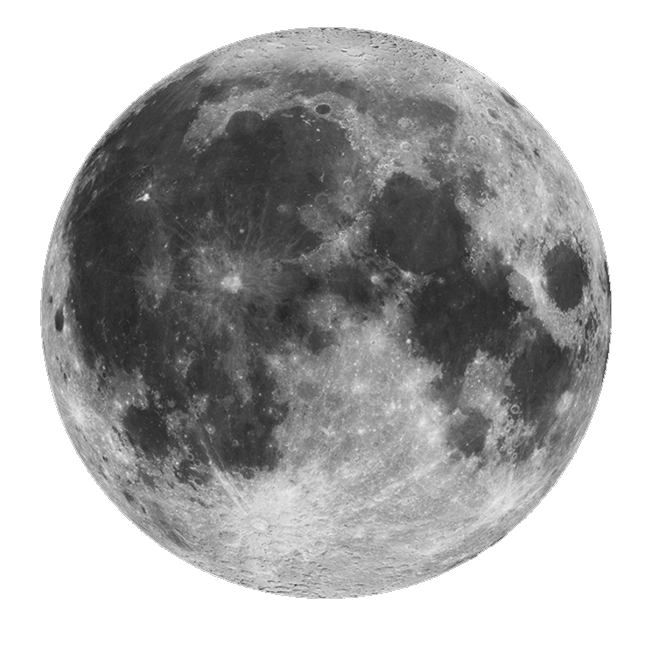
Credits
Author: Paul Rincon
Graphics: Gerry Fletcher, Lilly Huynh, Salim Qurashi
Images: NASA, Lockheed Martin, Phil Coomes, Foster + Partners
Producers: Tom Housden, James Percy
Editor: Kathryn Westcott